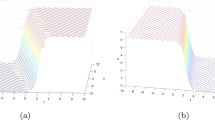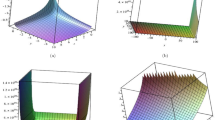Abstract
In this paper, it is shown how a combination of approximate symmetries of a nonlinear wave equation with small dissipations and singularity analysis provides exact analytic solutions. We perform the analysis using the Lie symmetry algebra of this equation and identify the conjugacy classes of the one-dimensional subalgebras of this Lie algebra. We show that the subalgebra classification of the integro-differential form of the nonlinear wave equation is much larger than the one obtained from the original wave equation. A systematic use of the symmetry reduction method allows us to find new invariant solutions of this wave equation.
Similar content being viewed by others
References
Ames, W.F., Lohner, R.J., Adams, E.: Group properties of \(u_t=[f(u)u_x]_x\). Int. J. Non Linear Mech. 16, 439–447 (1981)
Bluman, G., Cheviakov, A.F.: Nonlocally related systems, linearization and nonlocal symmetries for the nonlinear wave equation. J. Math. Anal. Appl. 333(1), 93111 (2007)
Fushchich, W.I., Shtelen, W.M.: On approximate symmetry and approximate solutions of the nonlinear wave equation with a small parameter. J. Phys. A Math. Gen. 22(18), L887 (1989)
Bluman, G., Kumei, S.: Symmetries and Differential Equations, Applied Mathematical Sciences, vol. 81. Springer, New York (1989)
Olver, P.J.: Applications of Lie Groups to Differential Equations, Graduate Texts in Mathematics 107. Springer, New York (1986)
Sattinger, D., Weaver, O.: Lie Groups and Algebras with Applications to Physics, Geometry and Mechanics, Applied Mathematical Sciences, vol. 61. Springer, New York (1986)
Rozdestvenskii, B., Janenko, N.: Systems of Quasilinear Equations and Their Applications to Gas Dynamics, Translations of Mathematical Monographs, vol. 55. AMS, Providence (1983)
Baikov, V.A., Gazizov, R.K., Ibragimov, N.H.: Approximate symmetries of equations with a small parameter (Russian) Akad. Nauk USSR Inst. Prikl. Mat. Preprint 1987, no. 150
Baikov, V.A., Gazizov, R.K., Ibragimov, N.H.: (2-AOS-M) Approximate symmetries (Russian) Mat. Sb. (N.S.) 136 (178) (1988), 435–450, 590; translation in Math. USSR-Sb. 64 (1989), no. 2, 427–441
Ruggieri, M., Speciale, M.P.: Lie group analysis of a wave equation with a small nonlinear dissipation. Ricerche Mat. 66, 27–34 (2017)
Patera, J., Winternitz, P.: Subalgebras of real three- and four-dimensional Lie algebras. J. Math. Phys. 18, 1449–1455 (1977)
Winternitz, P.: Lie groups and solutions of nonlinear partial differential equations. In: Ibort, L.A., Rodriguez, M.A. (eds.) Integrable Systems, Quantum Groups and Quantum Field Theories, pp. 429–495. Kluwer, Dordrech (1993)
Acknowledgements
AMG’s work was supported by a research grant from NSERC of Canada. AJH wishes to thank the Mathematical Physics Laboratory of the Centre de Recherches Mathématiques, Université de Montréal, for the opportunity to participate in this research.
Author information
Authors and Affiliations
Corresponding author
Ethics declarations
Conflicts of interest
The authors declare that they have no conflict of interest.
Additional information
Publisher's Note
Springer Nature remains neutral with regard to jurisdictional claims in published maps and institutional affiliations.
Appendix: subalgebra classification for the integro-differential case
Appendix: subalgebra classification for the integro-differential case
The Lie symmetry subalgebra for the integro-differential case given in Sect. 3 can be written as the semi-direct sum

The algebra \(\{X_5,X_6\}\) is Abelian and its subalgebra classification is given by
Using the method of splitting and non-splitting subalgebras as given in [12], we classify the one-dimensional subalgebras of the semi-direct sum (135). A basis element for each one-dimensional invariant subalgebra of \({\mathcal {L}}\) is transformed by the Baker-Campbell-Hausdorff formula in order to determine which other invariant subalgebras it is conjugate to. For instance, if we consider the subalgebra \(X=\{X_1\}\) and take an arbitrary element of the group generated by \({\mathcal {L}}\), \(e^Y\), where Y is the generator
we obtain
so the subalgebra \(\{X_1\}\) is conjugate only to itself. Applying this procedure to the other one-dimensional invariant subalgebras of \({\mathcal {L}}\), we obtain the following list of 63 one-dimensional subalgebras.
The following list constitutes the classification of the one-dimensional subalgebras of the symmetry Lie algebra for both cases of Eq. (120) (where the symbol \(X_6\) represents the symmetry generator (123) or the symmetry generator (130) respectively) into conjugacy classes.
The subalgebra structure of the integro-differential case is far more extensive than that of the three cases analyzed in Sect. 2.
Rights and permissions
About this article
Cite this article
Grundland, A.M., Hariton, A.J. Invariant solutions of a nonlinear wave equation with a small dissipation obtained via approximate symmetries. Ricerche mat 69, 509–532 (2020). https://doi.org/10.1007/s11587-020-00486-9
Received:
Revised:
Published:
Issue Date:
DOI: https://doi.org/10.1007/s11587-020-00486-9




